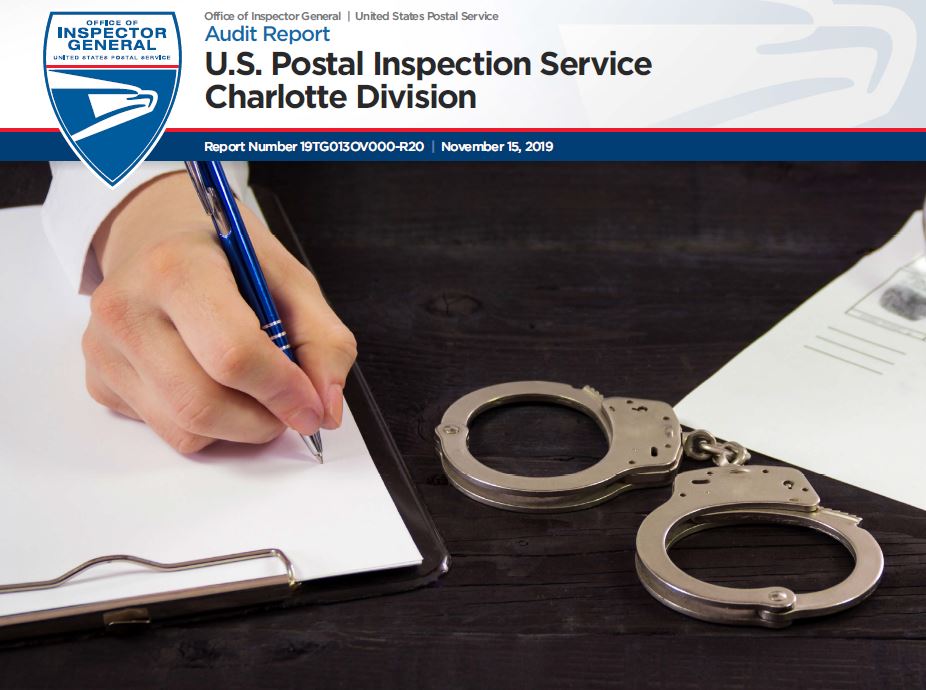Objective
Our objective was to determine whether the U.S. Postal Inspection Service, Charlotte Division, implemented effective controls for accountable property, training, and case management. Based on a risk analysis of closed case count and workhours, number of hotline referrals, and National Compliance Review occurrence, we selected the Charlotte Division. The OIG has a statutory requirement to provide oversight of Postal Inspection Service activities. As such, we plan to conduct similar reviews of other Postal Inspection Service divisions.
The Postal Inspection Service mission is to support and protect the U.S. Postal Service and its employees, infrastructure, and customers; enforce the laws that defend the nation’s mail system from illegal or dangerous use; and ensure public trust in the mail. Postal inspectors are federal law enforcement agents responsible for enforcing over 200 federal statutes that deal with the Postal Service and the mail.
Postal inspectors use various tools and resources to carry out their mission. Postal inspectors use the Case Management System, an online database, to open and close cases, and to document and track case activities. In addition, postal inspectors are assigned accountable property (e.g., firearms and vehicles) to perform their work.
The Charlotte Division has 78 postal inspectors and 37 postal police officers. In fiscal year (FY) 2018, the Charlotte Division had 387 closed, jacketed cases. A jacketed case is opened when there is indication or occurrence of criminal activity warranting further review. We reviewed a random sample of 60 closed, jacketed cases in FY 2018.
What the OIG Found
We found that the Postal Inspection Service properly inventoried accountable property. However, the Postal Inspection Service has not consistently implemented effective controls for ammunition storage, training, and case management. Specifically, we found:
- Charlotte Division Headquarters ammunition was secured in a storage room, but accessible to all 18 postal inspectors located at the division headquarters. In addition, management did not maintain an inventory or track ammunition.
- Inspection Service personnel did not record training courses accurately in the tracking system for 96 of 115 (89 percent) law enforcement officers. Of the 96 officers, the error rates ranged from 40 percent to 100 percent for 34 required courses not completed.
- Postal inspectors did not prepare field notes for 53 cases (88 percent), update investigative details every six months for 26 cases (43 percent), and jacket cases within seven days of the event for 10 cases (17 percent).
Overall, these conditions occurred due to inconsistently following policy and inadequate oversight. Specifically:
- Management interpreted the ammunition storage as secured because only postal inspectors have access to the storage room and no other administrative staff has entry. Also, Postal Inspection Service policy provides the latitude of storing ammunition in safes or locked cabinets if possible and does not restrict access to limited personnel. In addition, there is no formal requirement to inventory or track ammunition.
- Personnel manually entered the data into the tracking system, resulting in data entry errors. Also, there is no formal review to ensure the accuracy of the information.
- Postal inspectors attached other electronic documents instead of field notes to support cases or deemed field notes unnecessary if there were no witness statements. Also, postal inspectors did not consistently jacket cases within the prescribed timeframe due to other priorities. Additionally, management stated that postal inspectors did not believe they had to update investigative details every six months when cases were in pending, appeal, or prosecution status.
Prior audit reports identified issues related to ammunition inventory and case management requirements. These reports recommended management establish a formal process to periodically inventory and track ammunition; and provide refresher training to team leaders and postal inspectors regarding investigative documentation requirements, proper case closure procedures, and develop controls to ensure periodic reviews are conducted.
Management agreed and plans to establish a process for ammunition inventory and provide case management training by March 31, 2020, and September 30, 2020, respectively; therefore, we are not making recommendations.
What the OIG Recommended
We recommended management:
- Limit ammunition access to applicable personnel.
- Update policy requiring ammunition to be secured and limit access to applicable personnel.
- Develop a formal review process to ensure training records are entered accurately into the tracking system.
Read full report
Source: USPS Office of Inspector General

